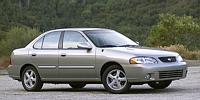2003 Car Review: Nissan Sentra 2.5 LE
SEE ALSO: Nissan Buyer's Guide
By Des Toups
Base price: $16,599
Price as tested: $17,139
EPA mileage: 23 city/28 highway
It’s 2003, but Nissan has conjured up 1968 with a small car just like
Detroit used to make: It goes like hell in a straight line but doesn’t like
corners, just like the V-8-stuffed Falcons and Novas that once ruled the
Saturday-night drags.
Even today, there’s still no substitute for cubic inches. In its new
Sentra 2.5 LE, Nissan has plunked an extra 45 or so under the hood of its
smallest, lightest car. The engine, a 2.5-liter double-overhead-cam
four-cylinder used in the pocket-rocket Sentra SE-R, develops 165
horsepower and 175 lb.-ft. of torque, the muscle that actually moves the
car. Both numbers are a third better than those produced by 1.8-liter fours
found in lesser Sentras.
While Nissan has shanghaied the engine from the sporty SE-R model, it left
out the firmer springs, anti-sway bars and meatier tires (and its
hey-look-at me wheels and day-glo interior). Instead -- to counter the
take-no-prisoners SE-R -- there’s an automatic transmission and milquetoast
tires, air, antilock brakes, a CD player and side airbags.
The feature list says cushy cruiser, but the engine still says, “Gee,
officer …”
The front tires spin with little provocation, from stoplights,
around corners, even when the transmission kicks into second gear on a damp
road. It's a blast if you're expecting it, somewhat unnerving if you’re
not. You’ll floor the 2.5 LE’s gas pedal, for example, to leave a parking
lot and claim a spot on a very busy road, but that’s just a recipe for the
tires to spin wildly, the tachometer pinned at redline as you creep along
at 10 mph. At the very least, the LE deserves more rubber on the road.
Feather the gas a little to get the Sentra rolling, however, and it’ll
lunge to freeway speeds with a ferocity that’s intoxicating. Power is
available instantaneously, with the four-speed automatic kicking down
quickly and decisively to deliver the goods.
Still, this is no undercover SE-R. The 2.5 is relatively softly sprung,
its steering far from razor sharp. Let the eager engine lure you into the
twisties and you’ll find yourself hammering the brakes before corners, then
patiently sawing at the wheel as you wait for some sign the front tires
have the grip to pull again. Graceful, it’s not. The 2.5 LE is by no means
a sloppy-handling car, only one whose abilities have been outstripped by
its engine. At least the 2.5 LE stops like an SE-R (albeit one on timid
tires): Four-wheel discs and ABS are standard.
The rest of the Sentra is basically unchanged, meaning if you didn’t
notice it before, you won’t notice it now -- unless you’re watching its
taillights pull away at a hard-to-believe rate.
The Insurance Institute for Highway Safety rates the Sentra Acceptable, a
notch below Good, in its offset crash-test results. The federal National
Highway Safety Traffic Administration gives the Sentra 4 out of 5 stars for
protecting driver and passenger in frontal crash tests, and it rates 4
stars out of 5 for rollover resistance.
The Sentra 2.5-liter is an Ultra Low-Emissions Vehicle and rates a 7 out
of 10 on the EPA’s air pollution scoring system (other versions of the
Sentra rate as high as a 10). This high-powered Sentra is comparatively
thirsty, with EPA ratings of 23 mpg city and 28 highway. We got just 20
mpg, not bad considering that our foot was gleefully pressed to the floor
the whole week.
Des Toups is a Seattle free-lance writer whose work has appeared in
AutoWorld magazine, The Seattle Times and newspapers nationwide.



